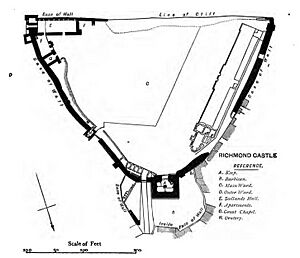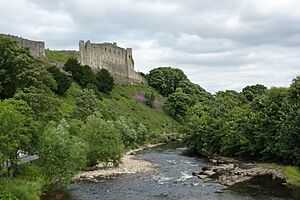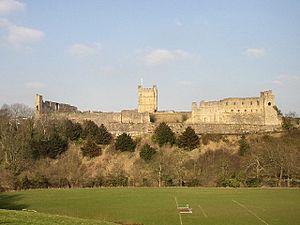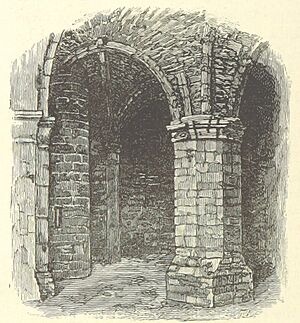Richmond Castle facts for kids
Richmond Castle is an old castle in Richmond, North Yorkshire, England. It sits high above the River Swale, right in the middle of the town. Its first name was 'Riche Mount', which means 'the strong hill'.
The castle was started in 1071 by a man named Alan Rufus. This was soon after the Normans took over England. The Domesday Book from 1086 already mentions a castle at Richmond.
In the 1100s, Alan's great-nephew, Conan, made the castle bigger and built the tall tower called the keep. Even though parts of it were ruined by 1540, it was fixed up much later. Today, Richmond Castle is one of the best-kept early Norman castles in England. It is also a very popular place for tourists to visit.
Contents
What Richmond Castle Looks Like
Richmond Castle has four main sections. There is a main area shaped like a triangle. To the east, there is an outer area. The tall tower, called the keep, is at the northern corner of the main area. There is also a small space built around the keep.
The Castle's Story
In 1069, William the Conqueror stopped a rebellion in York. After that, he carried out a harsh act called the "harrying of the North". This event caused many people to leave the area for a long time. To punish the people further, William gave the lands of North Yorkshire to his most loyal followers.
Alan Rufus, who came from Brittany, received the area of Richmond. He started building the castle to protect against more rebellions. It also helped him create his own strong base of power. His lands, known as the Honour of Richmond, covered parts of eight counties. This made it one of the biggest Norman estates in England.
Building the Keep and Stronger Walls
A tall keep was built around the end of the 1100s. It was made of honey-colored sandstone and was about 30 meters high. Duke Conan IV of Brittany started this work.
In 1158, Henry II of England took control of the Earldom of Richmond. King Henry II likely finished the keep. Its walls were very thick, about 3.3 meters wide. Today, visitors can climb to the top of the keep. From there, you can see amazing views of Richmond town.
At the same time, Henry II made the castle much stronger. He added towers and a barbican. A barbican is a special entrance area. It allowed guards to check visitors and wagons before they entered the main castle. Later, King Henry III and King Edward I also spent money to improve the castle. Edward made changes inside the keep.
Other Castle Areas
Besides the main walls, there was the barbican at the main gate. This was a closed-off space. It helped to check people and carts before they could enter the castle. On the other side of the castle, facing the river, was another area called the Cockpit. This might have been a garden. It had a balcony looking over it. An old drawing from 1674 shows another long balcony. This one looked over the river side of Scolland's Hall, which was the Great Hall.
Later Years of the Castle
Richmond Castle was not used as a fortress much after the late 1300s. It did not get many big updates after that time. A report from 1538 showed that parts of it were in ruins. But later, artists like Turner painted the castle. People also became more interested in old buildings and tourism grew. This led to repairs on the keep in the early 1800s.
In 1855, the castle became the main office for the North Yorkshire Militia. A military building was built in the big courtyard for soldiers. From 1908 to 1910, Robert Baden-Powell lived at the castle. He later started the Boy Scouts. He was in charge of the Northern Territorial Army at the time. The soldiers' building was taken down in 1931.
Richmond Castle During World War I
The castle was used during the First World War. It was a base for the Non-Combatant Corps. This group was made up of conscientious objectors. These were people who refused to fight in the war. Some conscientious objectors were also held prisoner here. They refused to follow army rules or take part in the war at all.
This group included the "Richmond Sixteen". They were taken from the castle to France. They were charged under army rules and sentenced to death. However, their death sentences were changed. Instead, they were given ten years of hard labor.
Hidden Passages and Legends
The original main gate arch from the 1000s is now in the basement. This is because the later 1100s keep was built in front of it. The original arch was opened up again in the 1800s.
Richmond Castle is a "scheduled monument". This means it is a very important historic building and old site. It is protected from changes that are not allowed. It is also a Grade I listed building. This means it is seen as an important structure around the world.
There are also some fun legends about the castle. One story says that King Arthur and his knights are sleeping in a cave under the castle. A potter named Thompson supposedly found them once. But he ran away when they started to wake up! Another legend tells of a drummer boy who got lost exploring a tunnel. People say you can sometimes hear his ghostly drumming around the castle.






